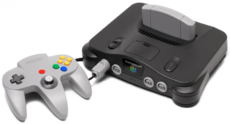Nintendo 64: Difference between revisions
No edit summary |
mNo edit summary |
||
| Line 9: | Line 9: | ||
|lifespan = {{Flag|Japan}} June 23, 1996 <br> {{Flag|North America}} September 29, 1996 <br> {{Flag|Europe}} March 1, 1997 <br> {{Flag|Australia}} March 1, 1997 | |lifespan = {{Flag|Japan}} June 23, 1996 <br> {{Flag|North America}} September 29, 1996 <br> {{Flag|Europe}} March 1, 1997 <br> {{Flag|Australia}} March 1, 1997 | ||
|media = ROM cartridge | |media = ROM cartridge | ||
|controllers = [[Nintendo 64 controller]] | |||
|compatibility = | |compatibility = | ||
|predecessor = [[Super Nintendo Entertainment System]] | |predecessor = [[Super Nintendo Entertainment System]] | ||
Revision as of 23:17, December 23, 2012
| Nintendo 64 | |
|---|---|
 File:Nintendo 64 logo.png | |
| Manufacturer | Nintendo |
| Type | Video game console |
| Generation | Fifth generation |
| First available | |
| Media | ROM cartridge |
| Controller input | Nintendo 64 controller |
| Predecessor | Super Nintendo Entertainment System |
| Successor | Nintendo GameCube |
| Article on Nintendo Wiki | Nintendo 64 |
The Nintendo 64 (ニンテンドー64, Nintendō Rokujūyon), often abbreviated as N64, is Nintendo's third home video game console for the international market. Named for its 64-bit processor, it debuted on June 23, 1996 in Japan, and was later released in North America on September 29, 1996, and in Europe and Australia on March 1, 1997. As of March 31, 2006, the Nintendo 64 has sold 32.9 million units worldwide.
On January 21, 1999, the Super Smash Bros series. debuted on this system with the original Super Smash Bros. in Japan, which was later released in North America that April. While not the best-selling game on the N64, it was the predecessor of Super Smash Bros. Melee which became the Nintendo GameCube's best selling title and spawned a equally successful sequel for the Nintendo Wii, Super Smash Bros. Brawl.
Another version of the Nintendo 64, called the iQue Player (神游機) is a video game system made by iQue Ltd., Nintendo's Chinese subsidiary. It is a variation of the Nintendo 64 hardware, specifically designed for the Chinese market. It is able to play several Nintendo 64 games, one of them being Super Smash Bros., among other best-sellers.
Impact to Smash Bros.
Playable Characters originating from N64
| Character | SSB | Melee | Brawl | Title |
|---|---|---|---|---|
| Sheik | The Legend of Zelda: Ocarina of Time | |||
| Wolf O'Donnell* | Star Fox 64 | |||
| Young Link** | The Legend of Zelda: Ocarina of Time | |||
| Ganondorf*** | The Legend of Zelda: Ocarina of Time |
*Wolf O'Donnell's first canon appearance was Star Fox 64; he initially appeared in the complete but unreleased Star Fox 2 for the Super Nintendo Entertainment System.
**Super Smash Bros. Melee states that Young Link debuted in The Legend of Zelda, but Link did not appear as a younger version of himself until The Legend of Zelda: Ocarina of Time.
***Although Ganon debuted in The Legend of Zelda, and was first called "Ganondorf" in The Legend of Zelda: A Link to the Past, Ganondorf in his human form did not appear until The Legend of Zelda: Ocarina of Time.
Cameos in the Super Smash Bros. series
- A Nintendo 64 can be seen in the trophy room in Super Smash Bros. Melee, with a copy of Super Smash Bros.
External links
- iQue Player website, in Chinese.
| Nintendo consoles | |
|---|---|
| Home consoles | Color TV-Game 15 · Nintendo Entertainment System · Super Nintendo Entertainment System · Virtual Boy · Nintendo 64 · Nintendo GameCube · Wii · Wii U |
| Handheld consoles | Game & Watch · Game Boy · Game Boy Color · Game Boy Advance · Nintendo DS · Nintendo 3DS |
| Hybrid consoles | Nintendo Switch |
